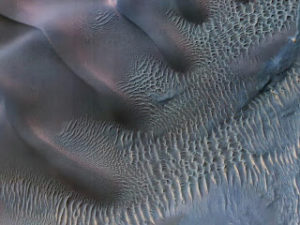
Image credit: NASA/JPL-Caltech/Univ. of Arizona
Given that the Mars rover Curiosity is in the news (it did not find methane in the planet’s atmosphere, contrary to earlier reports), this seems like a good time to pass along something I learned this week about the geological periods on Mars.
Mars is currently not a very happening place, geologically speaking—at least in terms of big events like volcanic eruptions and such. Its geological history is divided into three major periods, the latest of which has lasted for three billion years and counting. (The Earth has four periods, most of which are subdivided fairly finely.) Each period is named for a place on the Martian surface where features typical of that time period appear. The interesting thing to me, as a word geek, is that an alternative naming system has been proposed based on the geochemical events that were going on during each period. First, the current names:
Noachian: This period is named for Noachis Terra, a plain in the southern hemisphere that features some of the oldest landscapes on Mars, including large eroded craters. There may have been water: drainage networks formed by flowing water, and possibly even bodies of surface water. There were definitely impacts. This period lasted until about 3.7 billion years ago.
Hesperian: Hesperia Planum, also in the southern hemisphere, is a large lava plain. In Greek and Roman times, Hesperia was used to refer to the western regions. (For the Greeks, this was Italy; for the Romans, it was Spain.) Hesperus was the name given to Venus when it was visible in the evening, and the Hesperides were the nymphs who lived in a beautiful garden at the far western edge of the world. During the period named for this landform, there were lava flows and there was massive flooding that created outflow channels. It lasted until about three billion years ago (give or take; the boundary is fuzzy).
Amazonian: Amazonis Planitia, named after the mythical women warriors the Amazons, is a relatively young, smooth plain in the northern hemisphere, west of Olympus Mons. This period covers the last three billion years; there were lava flows (but not recently), glacial and other ice-related activity, and a whole lot of surface weathering.
The new names are:
Phyllocian: This runs through the early Noachian, about four billion years ago, and is named for the clay (phyllosilicate) minerals that formed during this period. The phyllo in phyllosilicate is the same root as in phyllo dough, and it goes back to a Greek word for leaf. Phyllosilicate minerals consist of parallel sheets, or leaves, of silicate tetrahedra.
Theiikian: During this period, volcanoes provided sulfur dioxide, which combined with water to form sulfuric acid, ultimately leading to the formation of silicate minerals. Thion, the Classical Greek word for sulfur, was adapted for the name of this period, which lasted until about three and a half billion years ago.
Siderikan: Think rust. After the volcanoes went quiet and liquid water all but disappeared, the rocks on the surface sat and oxidized, as they do to this day. This period is named for the iron oxides that give Mars its orange-red color. In Classical Greek, the word for iron is sidéros.
So there you have it. Enjoy your weekend, and if you get the chance, look for Hesperus, aka Venus, in the west just after sunset.
Learn more:
- News article from Nature on the latest Curiosity results, and the abstract of the paper in Science describing the results
- Although Mars was long thought to lack plate tectonics, there is now some evidence for a rudimentary plate tectonics system.